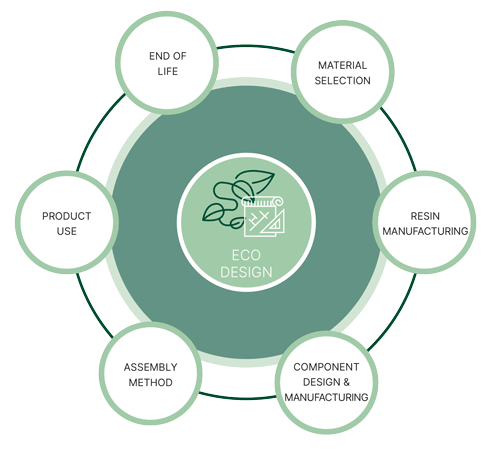Eco-design involves environmentally optimizing a new product at the drawing board stage.
Contact us
Sending Email...

FOCUS ON SUSTAINABILITY
Nolato's eco-design model
Eco-design:
The drawing board is the best stage to environmentally optimize a new product
Nolato has established an eco-design model to support its customers. The model aims to make it easier to minimize the overall environmental impact of new products.
“The drawing board stage is when it’s most effective to environmentally optimize a new product,” explains Glenn Svedberg, Nolato Group’s Head of Sustainability. “The model therefore reviews those aspects that are important to consider when designing new products.”

Choice of material is the foundation
“Independent analyses have demonstrated that plastic often has a smaller carbon footprint than both glass and metal,” says Nolato Head of Sustainability Glenn Svedberg. “But different plastics also vary considerably in terms of their carbon footprint. The type of plastic used also depends on the product’s area of application (pressure, temperature, tensile strength, dynamics/vibration, etc.).”
When Nolato’s experts propose a particular type of plastic, they always aim to replace traditional, advanced materials with simpler versions that are often more cost-effective and have a smaller carbon footprint.
But there are also other aspects that are important in the choice of plastic. The raw material, i.e. the basis used for manufacturing the selected plastic material, also plays a key role in optimizing the product’s overall environmental impact. “It’s important to find alternatives to fossil raw materials, such as materials that are bio-based or recycled, either mechanically or chemically,” notes Glenn Svedberg. “And then there’s the impact of transport, so we also have to think about where the raw material is produced.”
Other production factors are important too, such as the choice of renewable energy for the manufacture of the plastic material, and the manufacturer having certifications that confirm that the raw material is renewable.
Start at the drawing board
It’s the drawing board phase that determines how environmentally optimized the product will be and how much this will cost. Design is key to optimizing weight and a component’s structure based on specifications (strength, useful life, etc.).
Lower weight
Lower weight means less resource usage, as less material can be melted and cooled more quickly, making for a more efficient manufacturing process. Injection molds are designed for optimal cycle time and isolating sections that need to be heated from channels that cool the component. “The choice of other equipment is also crucial,” explains Glenn Svedberg. “The unit that controls heating and cooling in the different sections of a mold has a significant impact on overall energy use in injection molding. “The manufacturing location, i.e. the region and country, and the type of energy used to manufacture the product also have a major influence on the carbon footprint.”
Area of use and circularity
How the product is used also plays a major role in calculating its environmental impact. Is it a passive or an active product? An active product will continue consuming resources, such as energy, over its useful life. A fossil-based vehicle, for instance, has a significant carbon footprint when it is used, whereas an electric vehicle charged with renewable electricity has a much smaller carbon footprint. This stage of evaluation is, however, primarily for Nolato’s customer to assess.
“The final point that’s key to optimizing a product’s environmental footprint is circularity; that is, the ability to recycle the material when the product reaches the end of its life cycle,” says Glenn Svedberg. “A product can hardly be deemed to be environmentally optimized if it’s difficult or even impossible to recycle.”
If the product is assembled, the method of assembly is also significant. Where possible, the same material is used throughout to make it easier to recycle the product when it reaches the end of its life. However, different materials are often needed to optimize a product’s function, and this is beneficial if it can be easily dismantled during the recycling stage.
- Sustainability
- Nolato
- Nolato Magasin
You might also be interested in
SUSTAINABLE DEVELOPMENT
Creating sustainable solutions
ABOUT US
The Nolato Spirit
STORIES